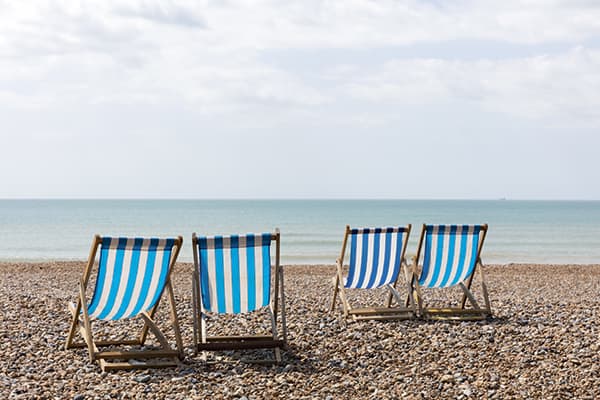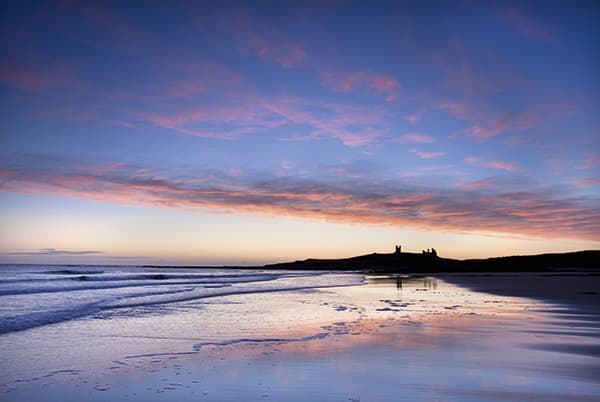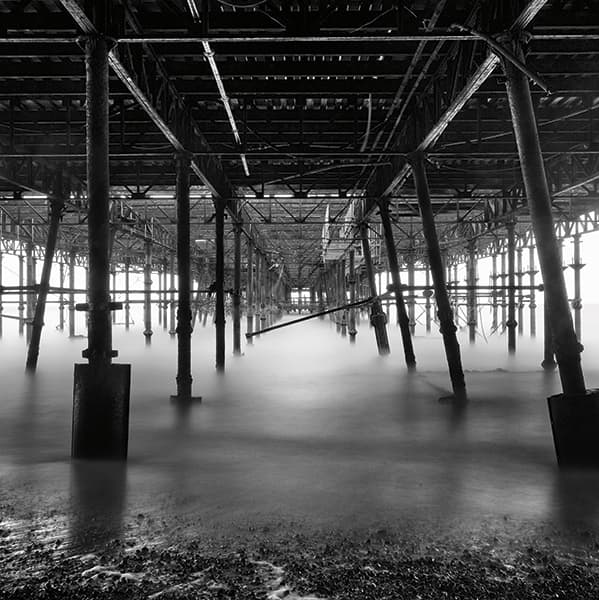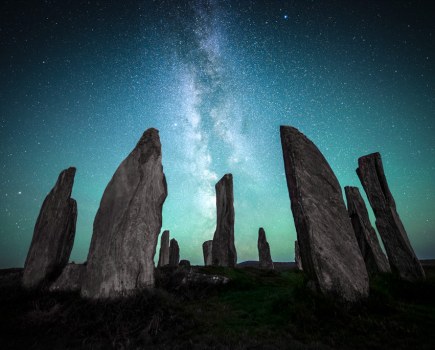
Kimmeridge, Dorset. The soft colours of dawn and dusk bring out the atmosphere of costal views. Canon E0S 1DS Mk III with 24-70mm zoom, 0.6ND grad, 15 seconds @ f/22, IS0 50.
The sea has always held a special place in my heart. I still have fond memories of childhood holidays on the Lincolnshire coast, building miniature fortresses in the sand, searching for crabs in shallow rock pools, flying kites on the breeze and listening to the gentle lapping of waves on the beach.
The coast is also the place where I cut my teeth as a photographer. During my teens, I patrolled Torquay seafront in search of candid subjects – pensioners snoozing in deckchairs, funny drunks posing for the camera, kids splashing in the sea. I also discovered the joys of night and low-light photography, shooting floodlit fountains, illuminations on the pier and neon signs outside bars and clubs.
For the past decade, I’ve lived by the sea in Northumberland, honing my craft as a coastal landscape photographer on its beautiful beaches, rocky inlets and tranquil estuaries. When you live somewhere long enough you get under its skin, tune in to its moods and feel like you belong. The ebb and flow of the tide, changing seasons and weather patterns become a natural part of daily life and outings with a camera are dictated by these factors – as well as the images that result.
What keeps me inspired more than anything when photographing the coastline is the variety of subject matter that the coastline presents – from dramatic views to small details, busy harbours to sandy beaches, natural beauty to manmade wonders. Come rain or shine, you will always find something interesting to photograph and it’s almost impossible to return home without a few great shots.
Tip 1: Time and tide

Bamburgh Castle, Northumberland. This is the kind of effect a 10-stop ND filter gives. Canon E0S 1DS Mk III, 70-200mm, 147 seconds @ f/22, IS0 100.
Try using long exposures to record motion in the sea and sky. I do this using a Lee Filters Big Stopper 10-stop ND filter, which slows exposures down to several minutes, even in the middle of the day. The resulting images have a surreal quality. The sea is smoothed out, clouds record as delicate streaks and static elements such as piers, jetties and rocks stand out starkly. Windy days are best, as you get lots of movement in the sky, though dull, overcast weather can also produce beautiful results, especially if you convert the shots to black & white. A 10-stop ND filter is almost opaque, so compose the shot and focus the lens manually before fitting the filter to your lens and set the shutter to Bulb. If the correct exposure without a 10-stop ND filter in place is 1/30sec, the exposure you need to use is 30 seconds, 1/15sec becomes one minute, 1/8sec becomes two minutes and so on.
Tip 2: Mono magic

Dungeness, Kent. Convert to b&w to add drama. Canon E0S 5D Mk III, 17-40mm, 1/160sec @f/11, IS0 100.
Although your first instinct may be to shoot the coastline in colour, the right scene can work even better in black & white, so don’t be afraid to convert it later. If the weather is rather flat and grey, this can be particularly effective – a colour shot will look boring, but in black & white you can produce stunning images in any conditions. I use Silver Efex Pro for b&w conversion – the Contrast and Structure controls are ideal for adding drama.
Tip 3: Closed for winter
There’s a quaint sadness about seaside towns out of season, boarded up and forgotten for months on end. They have the air of a ghost town, drained of colour and laughter, slightly forlorn and rough around the edges. However, that’s exactly what makes them so inspiring, so don’t limit your seaside visits to the summer months – get some dates in your diary for December, January and February.
Tip 4: Inspiring harbours
If beaches don’t do it for you, head for the nearest harbour. No matter what the weather’s doing, you can always find things to shoot, and even on the dullest, drabbest days, a quaint old harbour will keep you busy. Piles of rope, fishing nets, lobster pots, peeling paint, rusty chains, old boats, painted signs, reflections – there are endless subjects and all can be the source of great images.
Tip 5: Weather or not
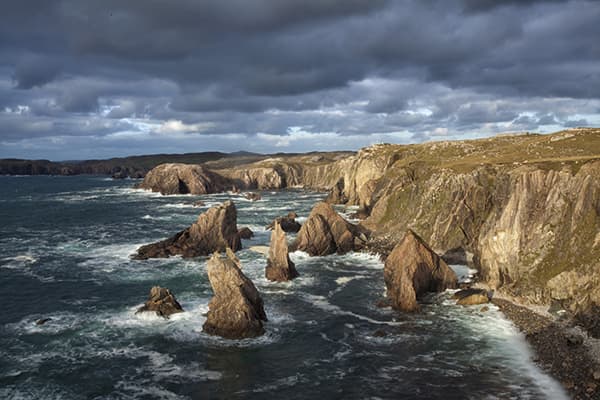
Mangersta, Outer Hebrides. Storms suit costal images. Canon E0S 5D Mk III, 17-40mm, 1/2sec @ f/22, IS0 50.
I love stormy weather as it reveals the raw power of nature. There’s always the risk of a soaking from falling rain and pounding seas, but the images can be magnificent. Use a waterproof cover to protect your camera, and fit an ND grad to your lens to darken the sky. To check the forecast, try www.metoffice.gov.uk, www.metcheck.com, or www.xcweather.co.uk – there’s no point heading out for sunrise if 98% cloud cover and heavy rain is forecast. During the day you can watch the weather change, so if you’re out you might as well make the most of it!
Tip 6: Life’s a beach
I love wandering along beaches, enjoying the view, looking for things to shoot. Ripples in the sand are a constant source of inspiration as they come in so many shapes and forms. I love the play of light on wet ripples; it adds a silvery sheen that contrasts with the darkness of the sand to create amazing patterns. Ripples also make great foreground in broader views and by getting low and close with a wideangle lens you can emphasise the shapes of the ripples nearest to the camera so they add scale and lead the eye into the scene. Reflections in rock pools are great for abstracts; flotsam and jetsam for details and textures; driftwood as natural sculptures; the skeletal remains of dead fish; love hearts drawn in the sand… there’s always something interesting to shoot!
Tip 7: Check the tide times
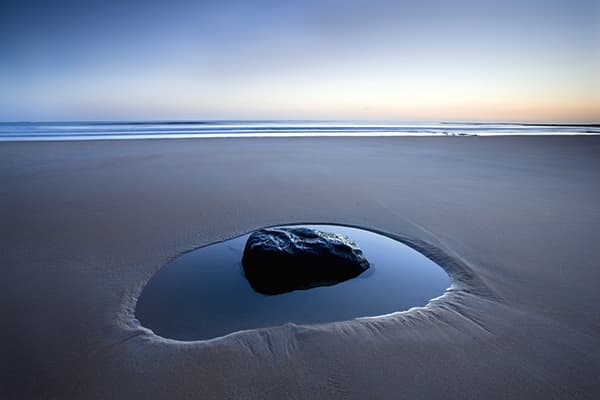
Get hold of a tide table for the area or check a website such as www.bbc.co.uk/weather/coast/tides/.
Knowing the state of the tide when you intend to visit a location can make a big difference to the photographs you take, so either get hold of a tide table for the area or check a website such as www.bbc.co.uk/weather/coast/tides/. If you want to capture ripples on a sandy beach at dawn or dusk, for example, the tide needs to be receding so the sand’s still wet and the ripples are fresh, but for waves crashing against the shore, high tide tends to be more dramatic. There are also serious safety implications – you don’t want to find yourself cut off by an incoming tide.
Tip 8: Make the most of light
Sunrise and sunset can be stunning as the vibrant colours in the sky are reflected in the sea, rock pools and wet sand. The first and last 30 minutes after sunrise and before sunset also produce beautiful golden light in clear weather and long, raking shadows, so it’s worth rising early and staying out late. A recce will determine if dawn or dusk is best for a particular location – don’t assume that you can’t get decent sunsets on the east coast or sunrises on the west coast; you can! Sunny, blue sky weather is the least effective for coastal views as the light is bland and harsh, but you can capture details and textures, or shoot infrared images with a converted DSLR or IR filter. Dull days are also good for detail shots and long-exposure seascapes
Tip 9: I’ll be back
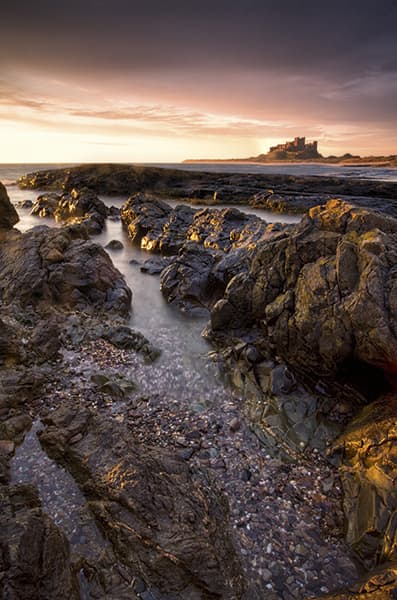
Bamburgh, Northumberland. if you live near a great location, make the most of it. Canon E0S 1DS Mk III, 17-40mm, 8 seconds @ f/22, IS0 50.
Although we have thousands of miles of coastline around Britain, there’s a lot to be said for returning to the same location time and time again so you get to know it intimately and can really make the most of its photographic potential. Andrew Nadolski did this by visiting and photographing Porth Nanven beach in Cornwall over a 10-year period and published a fantastic book of his work, The End of the Land. The images are well worth checking out either in the book if you can get hold of a copy or on Nadolski’s website (www.nadolski.com) as they provide a fascinating insight into what can be achieved, photographically, on one tiny beach. I’ve never invested that amount of time in photographing one location, but I’ve lived very close to Alnmouth beach on the Northumberland coast for over a decade and find it incredibly satisfying to simply go for a wander with a camera – any camera – and take photographs of anything that catches my eye.
Tip 10: Classic views
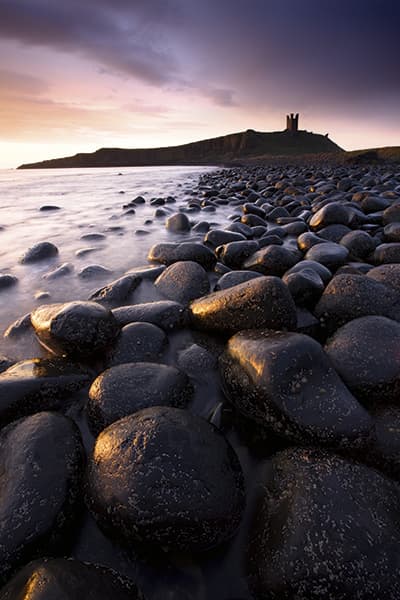
Dunstanburgh Castle, Northumberland. There are many iconic scenes on the British coast. Canon E0S 1DS Mk III, 17-40mm, 4 seconds @f/22. IS0 50.
The most dramatic coastal images tend to be those that adhere to the traditional principles of landscape photography – wideangle lens, foreground interest to add depth and lead the eye into the scene, front-to-back sharpness, a focal point to give a sense of scale and good light to bring out the character of the scene. It’s a simple formula to follow and provided that you don’t miss out any of the above factors you’ll be guaranteed great shots. I shoot most of my coastal landscapes at focal lengths (on full frame) of 24mm or wider, though I find the wide end of a 16-35mm zoom is ideal for emphasising near foreground and creating a dramatic sense of perspective and depth.
Tip 11: On the rocks
Rocks are full of wonderful patterns, texture and colours and are great for detail shots. Look for sedimentary swirls and soft curves in rocks that live below the high tide mark and course textures in those that stay above water but receive a pounding from the elements. Pebble beaches are another great source of patterns – look for groups in different sizes and colours and capture them in the soft light of an overcast day. I use a 24-70mm for rock details: it allows me to focus close and fill the frame with small areas.
Tip 12: Optical options
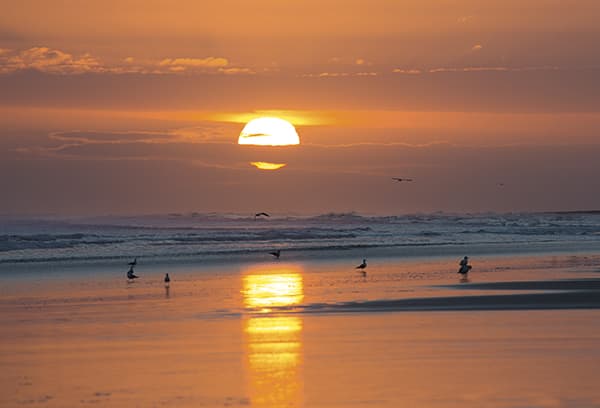
If you want to capture the sun’s orb at sunrise or sunset, the longer the lens the bigger the sun will be.
Although you’re more likely to use wideangle lenses to capture the coastline, don’t discount a telephoto or telezoom, too – in some situations it can work brilliantly. If you want to capture the sun’s orb at sunrise or sunset, the longer the lens the bigger the sun will be. You can also use a telezoom to home in on interesting parts of a scene, or to compress perspective so the elements in the scene appear crowded together.
Tip 13: Stretching the truth
With its uninterrupted views, the coastline lends itself to panoramic photography. You can either shoot a series of images then stitch them – I use Photomerge in Photoshop – or shoot a single frame with your widest lens then crop the top and bottom off. The latter option is fine if you’re not making big prints, but stitching is better for ultimate quality.
Tip 14: Piers of the realm
There’s something quintessentially British about the traditional seaside pier, stretching gracefully into the sea. Photographically, they also offer lots of creative potential. How about standing underneath the boardwalk so you can capture the legs and struts criss-crossing in silhouette with the sea and sky in the background, or shooting from one side to reveal the pier’s ornate structure in profile? In both cases, a long exposure can be used to blur the sea and sky so the pier stands out (see Time and Tide). On the pier itself, stand in the centre of the boardwalk at one end and shoot towards the other, using the converging lines to create a strong composition that carries the eye through the scene.




